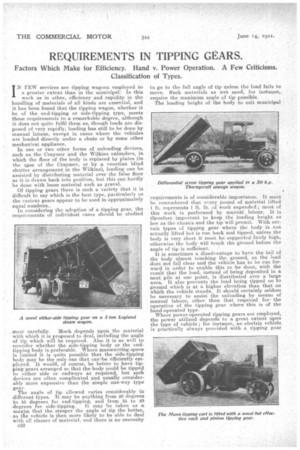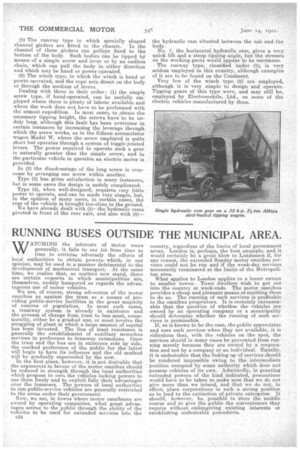REQUIREMENTS IN TIPPING GEARS.
Page 22

Page 23

Page 24

If you've noticed an error in this article please click here to report it so we can fix it.
Factors Which Make for Efficiency. Hand v. Power Operation, A Few Criticisms. Classification of Types.
IN FEW services are tipping wagons employed to a greater extent than in the municipal: In this work as in other, efficiency and rapidity in the handling of materials of all kinds are essential, and it has been found that the tipping wagon, whether it be of the end-tipping or side-tipping type meets these requirements to a remarkable degree, although it does not quite fulfil them as, though loads are disposed of very rapidly, loading has still to be done by manual labour, except in cases where the vehicles are loaded directly under a chute or by some other mechanical appliance. In one or two other forms of unloading crevices, such as the Craymer and the Wilkins unlaaders, in which the floor of the body is replaced by plates (in. the ease of the Crayrner, or by a venetian blind shutter arrangement in the Wilkins), loading can he assisted by distributing material over the false floor as it is drawn back into position, but this can hardly be done with loose material such as gravel.
Of tipping gears there is such a variety that it is difficult to say which is the best type, particularly as the various gears appear to be used in approximately equal numbers.. In considering the adoption of a tipping: gear, the requirements of individual cases should be studied
most carefully. Much depends upon the material with which it is proposed to deal, including the angle of tip which will be required. Also it is as well to consider whether the side-tipping body or the endtipping body is preferable. Where manceuvring space is limited it is quite possible that the side-tipping body may be the only one that cansbe efficiently employed. It would, of course, be better to have tipping gears arranged so that the body could be tipped to either side or endways as required, but such devices are often complicated and usually considerably more expensive than the simple one-way type gear. The angle of tip allowed varies considerably in different types. It may be anything from 40 degrees to 55 degrees for end-tipping, and from 35 to 40 degrees for side-tipping It may be taken as a maxim that the steeper the angle of tip the better, as the vehicle is then, more likely to be able to deal with all classes of material, and there is no necessity
c22 to go to the full angle of tip unless the load fails to move. Such materials as wet sand, for instance, require the maximum angle of tip possible.
The loading height of the body to suit municipal
requirements is of considerable importance. It must be remembered that every pound of material lifted 1 ft. represents 1 ft. lb. of work expended; most of this work is performed by manual labour. It is therefore important to keep the loading height as low as the chassis and the tip will permit. With certain types of tipping gear where the body is not actually lifted but is run back and tipped, unless the body is very short it must be supported fairly high, otherwise the body will touch the ground before the angle of tip is sufficient-. It is sometimes a disadvantage to have the tail of the body almost touching the ground, as the load does not fall clear and the vehicle has to be run forward in order to enablethis to be done, with the result that the load, instead of being deposited in a, neat. pile at one point, is distributed over a large area. It also prevents the load being tipped on to ground which is at a higher elevation than that on which the vehicle stands. It should certainly seldom be necessary to assist the unloading by means of manual labour, other than that required for the operation of the tipping gear where this is of the hand-operated type.
Where power-operated tipping gears are employed, the power utilized depends to a great extent upon the type of vehicle ; for instance, an electric vehicle is practically always provided with a tipping gear driven by a separate electric motor, usually of about 1 hp. In the steam wagon, power is sometimes obtained from the engine through direct connection or friction gear. Some makers utilize the feed pump, the water operating one or more hydraulic rams. It is in the petrol vehicle that we find the greatest variety of types. The hydraulic ram and the powerdriven screw appear to be about equally favoured, but these two general types are subdivided into a multitude of different designs.
In such work as dust-collecting, grit and dirt often prove deleterious to the tipping gear mechanism, particularly where this is not well protected. The protection of some types of tipping gear is extremely difficult ; this particularly applies to the ordinary screw and nut type, but wear may be to a Certain extent alleviated by extending the nut to form a housing for the screw. With the hydraulic-ram gear, little dirt can penetrate the barrel, as there is naturally an oil-tight gland which assists in cleaning the ram. It might 'be possible to protect some of the gears by means of suitable covers, and there is a certain amount of scope for inventors of such devices. We know of one case where the upper portions of the lifting screws were covered by cardboard tubes, which rose with the nuts, but these could not protect the lower portions of the screws, although they prevented road dust from accumulating on them when the nuts were at their lowest positions.
One of the simplest and best-protected hydraulic tipping gears is that utilized on the Halley tipping wagon. This consists of a double telescopic ram situated immediately behind the driver's cab. When the body is in its normal position, with the rams closed, they are both thoroughly protected from the entrance of dirt. This position of the hydraulic ram between the cab and the body appears to be fairly popular, but it has the disadvantage of occupying a certain amount of space which might, in other types, be usefully employed for the load.
In order to obtain the greatest possible tipping angle, many expedients are resorted to. In this connection the fuloruming of the body is of considerable importance. So far as the energy required in tipping is concerned, it is better to position the fulcrum as near the centre of the body as possible, so that the latter is almost balanced, but this centralizing of the fulcrum is limited by the drop of the rear of the body, and for this reason, in many vehicles, the fulcrum is practically at the rear so that the front of the body has to be lifted to a considerable extent, and the . tipping gear is called upon to perform a heavy task.
Where a hydraulic ram is employed, at about the centre of the body, it must be very strongly supported, particularly if it is fairly close to the fulcruming point, as the load at tho front end of the body then acts on it at a considerable leverage. Ili may be interesting to repeat here the classification of end-tipping gears which we published in December, 1919.
(1) The simple single or twin-screw, pivoted at its base and operated either by hand or by power. Itis sometimes geared down and may he arranged to give a quick return of the, body to the horizontal position.
(2) The differential screw. This consists of one screw operating within the other, so that when the inner screw reaches the limit of its travel the outer screw begins to turn. This type can be made to give either uniform speed of lift or two different speeds.
(3) The horizontal, simple, single or twin screws, with either plain or toggle-jointed levers. In this type the body usually runs back some distance until the load practically balances over the pivoting point.
(4) The horizontal, simple screw with a plain pushrod attached to its nut. The body in this type.is fitted with rollers and runs back on specially shaped guides, attached to each side member of the frame.
(S) Single or double hydraulic rams pivoted in front. of the rear axle and practically in the vertical plane. (6) A hydraulic ram acting in a virtually vertical plane, but situated between the tab and the body, and lifting the body through the medium of pulleys, carried at the top of the ram, which carry wire ropes attached at one side to the frame and at the other to the body. (7) The horizontal hydraulic ram, by which two levers, pivoted at their bases, are pulled into an upright direction against two rollers fixed to the bottom of the body. As the levers lift, the rollers run up them and so raise the body. (8) The runway type in which specially shaped channel girders are fitted to the chassis. In the channel of these girders run pulleys fixed to the bottom of the body. Such bodies can be tipped by means of a simple screw and lever or by an endless chain, which can pull the body in either direction and which may be hand or power operated. (9) The winch type, in Which the winch is hand or power-operated, and the rope acts direct on the body or through the medium of levers.
Dealing with these in their order: (1) the simple screw type, if hand-operated, can be usefully employed where there is plenty of labour available and where the work does not have to be performed with the utmost expedition. In most cases, to _obtain the necessary tipping height, the screws have to be unduly long, although this fault has been overcome in certain instances by increasing the leverage through which the screw works, as in the Edison accumulator wagon Model W, where the screw employed is quite short but operates through a system of toggle-jointed levers. The power required to operate such a gear is naturally greater than the simple screw, and in the particular vehicle in question an electric motor is provided.
In (2) the disadvantage of the long screw is overcome by arranging one screw within another.
Type (3) has given satisfaction in many instances, but in some cases the design is unduly complicated. Type (4), when well-designed, requires very little power to operate, and can be made very simple, but, in the opinion of many users, in certain cases, the rear of the vehicle is brought tooselose to the ground. We have already dealt with (5)—the hydraulic rams pivoted in front of the rear axle, and also with (6)— the hydraulic ram situated between the cab and the body. NO. 7, the horizontal hydraulic ram, gives a very quick lift and a steep tipping angle, but the stresses on the working parts would appear -to be enormous. , The runway type, classified 'under (8), is very seldom employed in this country, although examples of it are to be found on the Continent.
Very few of the winch type (9) are employed, although it is very simple to design and operate..
Tipping gears of this, type were, and may still be, employed by Electromobile, Ltd., on some of the electric vehicles manufactured by them.






































